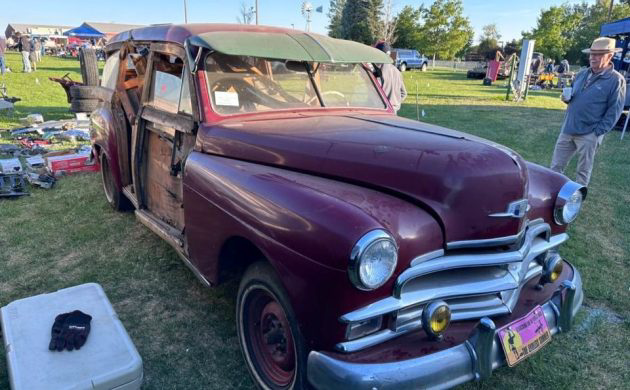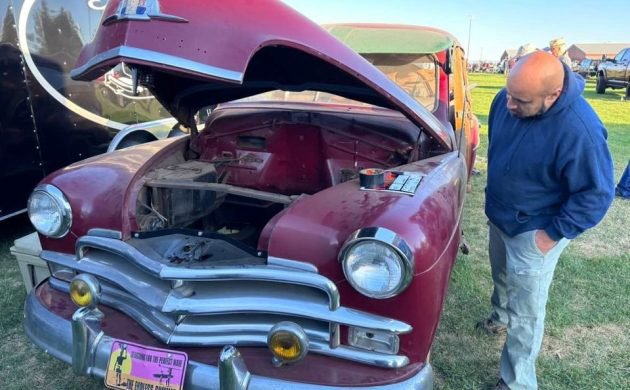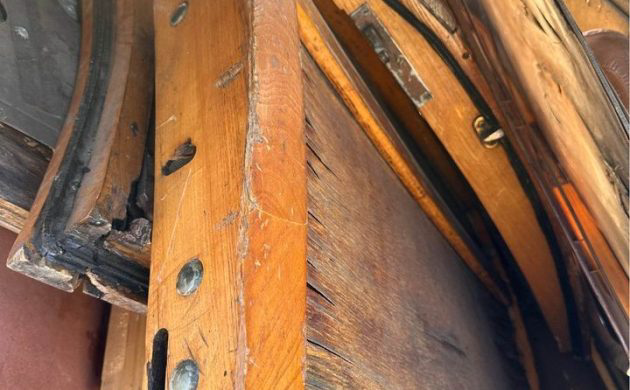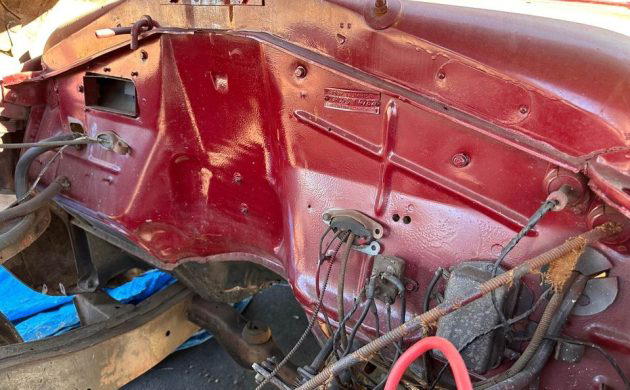These days it is hard enough to resurrect a classic vehicle considering our universal constraints on time, energy, and folding money. So, if that vehicle’s return to glory requires an additional type of hard-won talent, is it possible for the average enthusiast to take it on as a project? Take for example this 1950 Plymouth woody wagon that faithful reader T.J. has found for us. For sale on Facebook Marketplace, this forlorn Plymouth looks to be complete, but the wood bodywork is little more than kindling at this point. Is this rare Plymouth worth restoring at an asking price of $8,500?
Wood-bodied station wagons were quite collectible at one time. Major auction houses competed for excellent examples to roll across their auction blocks. Luxury car magazines such as the duPont Registry often featured these distinctive pieces of Americana on their thick and glossy pages. They brought big money back in the day. Some even sold in the low six figures. Then, as often happens in America, tastes changed and the market for this type of vehicle and their wood-clad automobile cousins got very soft very quickly.
What happened? As mentioned, the market is fickle on its best day. It may have also been that people figured out that the best ones had already been scooped up and that the examples that hadn’t been restored were difficult to bring up to a high standard. The type of craftsman that can take a derelict wood-bodied vehicle apart, determine the proper dimensions of each part based on shrunken, dried, and rotten wood, and carefully assemble the new wood perfectly was always an endangered species. When you consider that our ever-modernizing world has less and less use for such artisans, you can see how the few capable of resurrecting such a vehicle can pretty much name their price for their efforts. That price probably exceeds the value of nearly any wood-bodied car you can find at this point. This is not a job that a weekend warrior headed to Home Depot on Saturday morning should attempt.
You also have to consider that keeping the bodies of these cars in shape requires yearly maintenance. That maintenance will be a lot more involved than going to town on the body with a can of Lemon Pledge and some old T-shirts. Sanding and varnishing are not enjoyable pastimes. One has to wonder why Detroit produced wood-bodied vehicles after World War II in the first place. The technology was there to make steel-bodied wagons, and Willys successfully did just that. It seems that the considerable amount of labor and financial outlay needed to produce these vehicles at the scale they were manufactured was rather nonsensical in hindsight.
Perhaps it was simply customer demand for such a vehicle. Almost every flawed creature is beautiful in its own way, and there is nothing more handsome than the image of a woody wagon going about its work. That work may be hauling surfboards and teenagers to a beach. Or it is picking up passengers at a train station, with a bellowing steam locomotive in the background hooked up to a sleek line of aluminum passenger rail cars. Perhaps the most beautiful is the sight of a woody wagon sitting next to a pond or a forest of trees, with a sportsman and their dog preparing for the day’s activities. Maybe even with a picnic basket on the tailgate if that is how you imagine your heaven to be.
Sadly, this woody wagon is a pretty far distance away from heaven right now. This 1950 Plymouth Deluxe wagon is crying out for a proper restoration. The chassis and cowl look to be perfectly restorable. Above, the picture shows the area where the engine formerly sat. It is currently out of the car along with the transmission and described as “great.” It was removed to shoehorn a Small Block Chevrolet V-8 in there somehow. Fortunately, the torch hadn’t come out before the project was wisely abandoned by the looks of the cowl. The only abuse it seems to have suffered was at the hands of someone with a paintbrush instead of a spray gun.
Other than the engine and transmission’s vague status, we don’t know much else about the car. We are told that it is titled in Oregon and has a California tag. It is described as having eight doors and three rows of seats. The seat part makes sense, but the door part must be some of that Common Core math they teach in schools now. It is hard to believe that the seller has spare woody wagon doors. At any rate, the doors are stacked like cordwood inside the car, so it is hard to visually verify this. What would be great is if the seller published pictures of the individual doors so prospective buyers could get an idea of how much is left to form patterns.
All and all, this is a desirable car at a tempting price. If you think a woody is worth the added expense and aggravation that is. If it were yours, do you have the skills to take this one from kindling to a finished project before the century is out? Is there anyone left out there with the carpentry skills needed to make this beauty shine like new? Please share your thoughts in the comments.







any wooden boat shop — E or W coast could put all the wood repair work together.
The way things are mass produced now leaves me amazed the amount of work and skill it took to build one of these in the first place. When these were new they were pretty pricey, for many makers the most expensive car in their lineup. I hope somebody steps up to save this one, be a shame to make it into a hotrod. As Jeff said Willys made the first all steel wagon, I think Plymouth was second with their smaller wheelbase 2dr. wagon. Even Packard got into the wagon game briefly with a woody in the late 40’s. But here’s a question does any know who made the last woody wagon?
I would assume it was Morris, makers of the Traveller until 1974-5?
Long before me but like anything, these were mass produced and like any other vehicle required repairs when involved in collisions. Over the years certain car items have passed through my hands. One item was a crash book from the mid 50s. At that time, the Iona furniture company handled the wood replacement pieces for these cars. That book even went further with diagrams and measurements of each piece. Pieces, there are many on these. I gave that book to a guy pulling his hair out over a 50 Pontiac unit. These were basically the four door sedan with the upper body left off from the windshield back. Kind of like some of the commercial chassis and a more note worthy one. The hardtop Caballero and Fiestas that were also done from the 4 door hardtop by Iona. Search out those books, I believe it was by Mitchell. Buy a bunch of woodworking stuff or find Norm Abrams and go for it. That book fascinated me, all the pieces, measurements and stuff that went into building these.As said above, it was the likely reason these types of vehicles were the most expensive in each makers lineup, just for the labor and craftsmanship that went into constructing these.
One other item. That book listed the cost of each piece if you purchased it through them and even had a time listed for delivery.
Tastes change when deep pocket folks bought nice ones for a lot of money and discovered they could never park them outside overnight or let them get wet or rained on or washed.
As an appraiser, I believe this car, as it is, is worth no more than $2500. and that’s being very generous. The return on your investment of time, energy and money will not come close to what you put into it. Aside from the unknown engine / trans problems, the intense labor to reconstruct this is immense and very expensive.
I am fairly handy doing woodwork. I took a long, hard look at one of these a couple of years ago. I figured it would take about 1,000 hours to fully restore just the wood on that one and this one would probably take the same amount of time. In addition, add in the cost of the wood, any special tools and other expendables needed and you are looking at a very large chunk of change (a minimum of a 14″ band saw will be needed for some of the cuts). With no pictures of the engine or transmission, I would have to say that the price is a bit high.
Last domestic wagon with real wood, I think was the ’53 Buick, and it was mostly metal. Last Ford/Mercury was the ’51, and tailgate was metal and fake wood. Well off neighbor had a ’48 Ford which was lots of real wood, and I owned the remains of a ’40 Ford Standard, which had enough wood left for patterns, $75, sheet metal was really good, seat frames, most glass, trim, were there, sold it for $225 when it was clearly far beyond my time, money, and ability to restore. No engine or transmission, but I had figured that they were easy to find.
I’ve got an identical one in northern MI sitting inside that would cost you a LOT less to get started on your woodworking project!!!!
Is it just me or are all the pictures taken to show as little detail as possible?
I assume anyone who is considering buying this car would want a lot more information and hopefully an in person inspection before putting down any money but still, ads like this basicly end any interest I have in a vehicle.
I would love to restore it to stock, including the 218 CID flat six engine.
The bones look good. Here’s hoping it goes to an owner who won’t rod it.